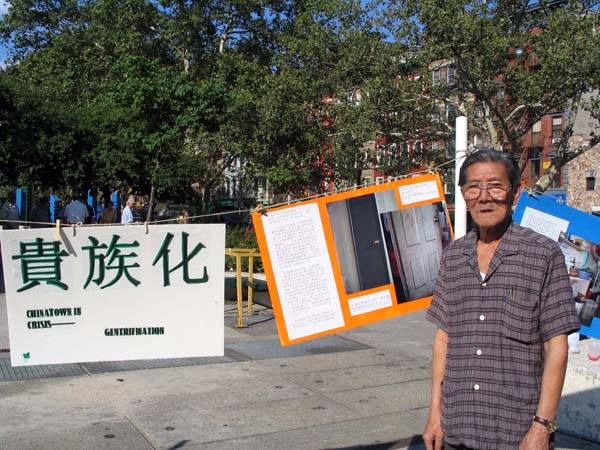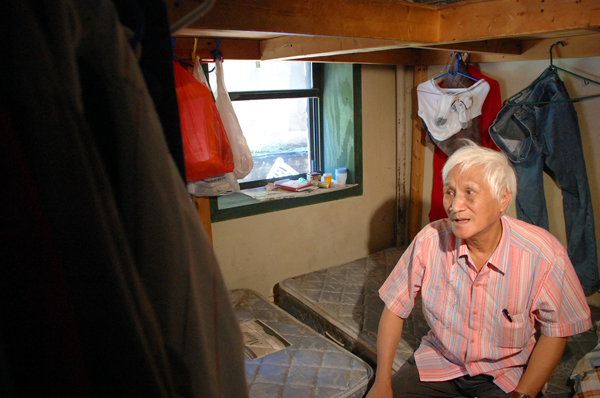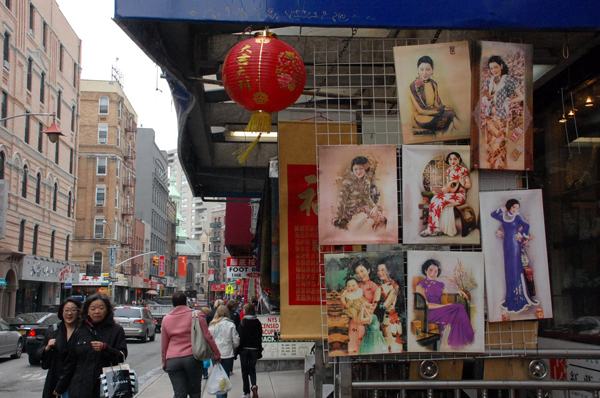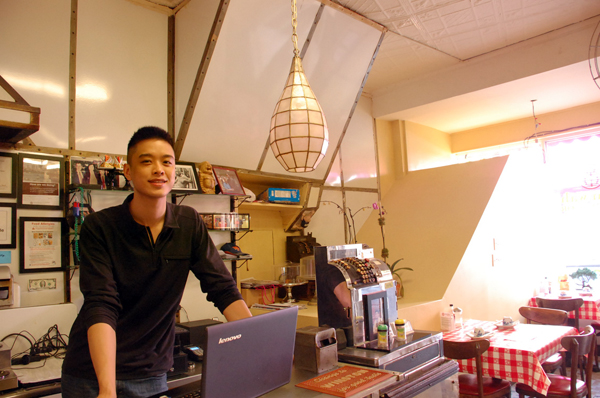
A senior tenant in Chinatown at a street exhibition on gentrification in the neighborhood held by grassroots organizations in 2005. (Photo: Rong Xiaoqing)
The tenements where a dozen day laborers share a single room full of bunk beds are still easy to spot. The stores and restaurants are crammed together, their banners chaotically competing for attention. You still have to push and elbow your way through the sea of people on the street. But when the 2010 Census results, which were announced late last month, found the population in Manhattan’s Chinatown had dropped 8.7% in the past ten years, Wellington Chen felt it was a nightmare come true.
“I always feared this would happen. All traditional neighborhoods that couldn’t adjust well to the modern society will shrink eventually. Look at Little Italy,” said Chen, the Executive Director of Chinatown Partnership Local Development Corporation (CPLDC), a nonprofit organization that focuses on community development.
This might be the first population dip since the repeal of the Chinese Exclusion Act in the mid-1960s that spurred an immigrant influx into Chinatown. But not everyone here believes their neighborhood is at risk of shrinking like the neighboring Little Italy, which sprawled seven by seven blocks wide in its heyday, and now has shrunk to just four blocks along a single street.
In fact, the accuracy of the Census figures has raised many questions in Chinatown as they have through the rest of the city. Mayor Bloomberg, who ridiculed news that New York’s population had only jumped 2.1% to 8.17 million in the past ten years, has formally filed a request for correction.
But even those who doubt the accuracy of the Census count agree that Chinatown’s demography has changed significantly since 2000, placing the neighborhood at a crossroads. What people in the community cannot agree on is how it reached its current form, and which way should it now go.
Michael Misko, a veteran coordinator at the polling station at I.S.131 said he greeted many more young white voters in the elections last November than he ever had in the past. “It showed that many young whites have moved into Chinatown,” he said.
Jan Lee, whose family has been renting out their 16-unit apartment building over the past 45 years, says there are fewer tenants in the building. “Our tenants used to be working families with four or five people living in the same apartment. But many of them have been replaced by young professionals living alone,” said Lee.

74-year-old Fugao Pan complained his landlord left his rent controlled apartment dilapidated in order to force him out. (Photo: Rong Xiaoqing)
This doesn’t mean the Chinese community in the city is shrinking. Citywide, the Asian population increased 31.8 percent to over a million, making it the fastest growing ethnic group in the past decade. It’s notable that the population in other major Chinese-dominated neighborhoods has risen as Manhattan’s Chinatown has shrunk. Flushing in Queens, for example, has seen a 3.8 percent jump and Sunset Park in Brooklyn leaped 9.4 percent.
The areas around Chinatown, from the Lower East Side to Battery Park City, have all been growing, which is why the overall population in City Council District 1, which includes Chinatown, actually grew overall. City Council member Margaret Chin, a Chinese American who represents District 1, pointed out that the total Chinese population in her district may not have dropped at all because there has been an increase in Chinese Americans living in the neighborhoods surrounding Chinatown (This could not be confirmed because the Census Bureau hasn’t released the city’s detailed figures of race and ethnicity yet).
Still, the population drop in Chinatown is undeniable. The reasons for the change? It depends on who you ask. “There are more and more luxury buildings and not enough affordable housing for low income people. Many low income people have been pushed out,” said Hua Lee, a coordinator at the Chinese Staff and Workers Association (CSWA) that represents low-income residents. But for Chen from the CPLDC, the reason is that Chinatown is too old—dilapidated, untidy and smelly. “There aren’t many things that attract young people. When the younger generation grew up or when the new immigrants get the financial means, they all moved out for a better quality of life. That’s what happened to Little Italy.”
The two opinions are not necessarily conflicting. But in Chinatown they have been the basis of a tit-for-tat debate ever since the September 11 attacks almost 10 years ago.
In 2004, Chen’s CPLDC was established with $7 million funding from the Lower Manhattan Development Corporation to rebuild the neighborhood whose vibrancy had been hit due to its proximity to Ground Zero.
Chen used most of the funding to hire a sanitation team which keeps the streets clean. But what he really wanted was not just cleaner streets, but also a sustainable program to overhaul the image of Chinatown. So he proposed a plan to the community to set up a Business Improvement District (BID) in Chinatown right after he got the CPLDC position.
That was a time when the real estate boom had already led to the construction of some new luxury buildings in and around the area, and numerous landlords were trying to deregulate rent-stabilized and rent-controlled apartments so they could charge market rents – often through ugly eviction attempts.
But the idea of the BID, which would require landlords and business owners to pay an annual fee to maintain and improve their own neighborhood, immediately faced opposition from grassroots organizations. The CSWA, for one, worried that landlords and businesses would squeeze tenants and workers to pay the fees.
The debate has become more intensive since 2008 when the city approved the Lower East Side rezoning, which limits the height of new buildings in much of the area. Worrying it would push more luxury building developers to nearby Chinatown, a group of residents, advocates and businesses in the neighborhood quickly formed the ad hoc Chinatown Working Group to draft their own rezoning proposal.
This became a new arena for wrestling. People who are eager to see a “new Chinatown” welcome developers as long as they follow the city’s inclusive zoning principles and allocate 20 percent of their apartment units to affordable housing. People who say they support neighborhood preservation want the affordable housing obligation for developers to be raised to 60 percent and the apartments to be affordable to families with a $35,600 annual income–half of the $70,900 citywide threshold –a plan opponents said would drive away developers and leave Chinatown as an undesirable ghetto.
“Chinatown needs low-income new immigrants as well as a younger generation with better means. A big challenge for us is to find the room for negotiation,” said Gigi Li, co-chair of the Chinatown Working Group. “But to refuse changes is not realistic.”
So far, the Chinatown Working Group hasn’t been able to achieve their goals. But changes are on the way. The BID proposal has recently been approved by the Department of City Planning and is pending in the City Council. Full of hope, Chen of LMDC is thinking big as he eyes the potential funding collected under the BID. Included in his plan are lighting up Chinatown at night, the creation of outdoor cafes and tea houses and various theme festivals. “We need to bring more people here to help the local businesses and we need our young people to enjoy Chinatown rather than covering their nose and running away,” said Chen.
In the heart of Chinatown, 32-year-old Wilson Tang is also trying to find a balance. The finance major who had worked for banks like Morgan Stanley and ING Direct, took over the 90-year-old Nom Wah Tea Parlor on Doyers Street from his 83-year-old uncle Wally at the end of last year.
Already, the oldest shop in Chinatown, where things had been kept the same for decades, is tasting a fresh breeze—the kitchen appliances are all brand new, there is a new stereo system that sometimes blares music from Ipods, it has a Facebook account, and Tang has applied for a liquor license. But the traditional setting in the dining room and the historic awnings are maintained.
“I am young. Of course I want to attract more young people like myself. But at the same time, you cannot abandon the tradition. It cannot be duplicated and it is valuable. This is not easy,” Tang said.
Rong Xiaoqing is a reporter for Sing Tao Daily New York. Fi2W is supported by the New York Community Trust and the John S. and James L. Knight Foundation with additional support from the Mertz Gilmore Foundation.






